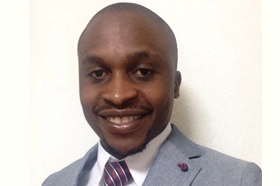Hardware Architecture Design and Optimization of Real-time Enhancement and Haze Removal

Division of Media and Network Technologies
Research Group of Image and Video Processing
Laboratory of Information Communication Network
DC the third year
Kasauka Dabwitso (Nationality: Zambian, Year of enrollment: 2013)
In introducing my research, firstly I would like to state that nothing is impossible! Everything is possible with the right attitude, patience, resilience and teamwork. With that out of the way, my current research stemmed from a branch in digital image processing called image smoothing. This was my Master degree research topic. It involved the decomposition of an image into salient structures and fine detail layers, following the independent manipulation of these components. Smoothing represents the removal of fine details while retaining major features (areas of sharp discontinuity). The main challenge of image smoothing is designing an algorithm that can correctly classify and manipulate these features independently. Many researchers have proposed edge-aware smoothing algorithms which suffer from high computation complexity. Less computational smoothing algorithms tend to fail to classify features correctly leading to edge blur. My research focus was to reduce computation complexity without compromising the quality of smoothing. Upon successful algorithm design and implementation, I moved onto researching hardware architecture design and optimization for real-time image (video) enhancement and haze removal using a single module.
In recent years, much research interest has developed in image enhancement and haze removal techniques. Digital image and video processing plays an essential role in modern day consumer electronics, with the increasing demand in digital media driven by current social trends. With continued advancement in digital imaging applications, real-time image (video) enhancement and haze removal are among key research topics influencing consumer electronics. The need for efficient architecture design incorporating two computation costly processes, haze removal and Retinex-based enhancement, is necessary. The quality of images and video taken from outdoor scenes is influenced by scattering of light which occurs before reaching the camera sensor. The amount of scattering depends on the distance between the scene points and the sensor, making degradation spatial-variant. In haze (fog) weather, an elevated presence of atmospheric particles such as water-droplets results in more scattering, resulting in low contrast and color fidelity images. Scattering is caused by two basic phenomena, which are attenuation and airlight. Haze removal depends upon the unknown depth information. This particularly makes haze removal a challenging task. Haze removal is highly desired in computer vision applications. It not only serves to significantly increase the visibility of the scene and correct the color shift, it can also benefit many vision algorithms and advanced image editing. We have proposed an architecture supporting both real-time Retinex-based image enhancement and haze removal, using a single module. We substitute a process intensive component widely implemented in haze removal using soft matting by our modified Retinex-based enhancement. This is possible because of the spatial smoothness characteristic of illumination estimation in Retinex-based enhancement. My research involves mathematical algorithm development, software coding and optimization and finally translating to hardware architecture design and implementation. With this, full HD video real-time processing has been accomplished at 60 fps utilizing low hardware resources. Currently working on further optimization and performance evaluation under different atmospheric light and fog conditions. The overall target is to produce low power processing devices that can easily be integrated in on-board vehicle cameras, remote monitoring sites, etc. This would also aid other computer vision processes such as used in robotics.
Life in my laboratory has been interesting as it has been like a home to me for 6 years. I have made many friends, and bid farewell to many who graduated before my time. Our laboratory has a balanced work culture thanks to our professors. Students work hard and also take time to relax and play in the lab. I believe this flexibility has been key to the success of our laboratory. Furthermore, we have lab parties for various occasions both within the University and outside. Our laboratory has had a considerable high diversity, with international students from China, Thailand, Myanmar, Zambia, Jamaica and Sweden just to mention a few. Nevertheless, majority of students are Japanese.
Currently we have three professors in our lab, including one from America. The main research groups can be classified in three categories; 1) Speech recognition, 2) Computer vision (image and video processing), and 3) Wireless networks. All three require fundamental knowledge in digital signal processing and programming. The professors guide the students on research topics, following current trends in technology advancement. The majority of students are enrolled in Master degree program, with a few pursuing PhD. Every semester, each student is required to present their research work at least 5 times. These meetings are held once every week, with three or four presenters per session. Japanese and English presentations are both acceptable. These presentations provide a platform for students to interact with the presenters, contributing ideas to advance their research work. Furthermore, the professors provide positive criticism and direction to each presenter. Lastly, our laboratory has various collaborations with international Universities. This has also provided the opportunity for staff and student exchange programs, further promoting knowledge and cultural exchange.
I have enjoyed my time at Hokkaido University, developing both professionally and socially. I hope you have an equally, if not a better experience during your study.

